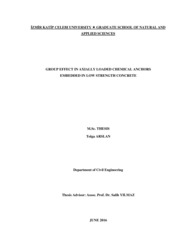Group effect in axially loaded chemical anchors embedded in low strength concrete
-
Eser Sahibi
Arslan, Tolga
- Tez Danışmanı Salih YILMAZ
-
Tür
Yüksek Lisans
- Yayın Tarihi 2016
-
Yayıncı
İzmir Katip Çelebi Üniversitesi Fen Bilimleri Enstitüsü
- Tek Biçim Adres Http://hdl.handle.net/11469/639
-
Konu Başlıkları
Kimyasal ankraj
Chemical anchor
Grup ankraj etkisi
Group anchor effect
Düşük dayanımlı beton
Low strength concrete
The use of chemical anchors for the connection of existing structural elements with
the new elements during strengthening of existing structures is quite a preferred
method. Since in our country, chemical anchors are being widely used for repair and
strengthening works, there should be a standard of design and application on this topic.
Up to now, research done on the topic of chemical anchors, are mostly carried out on
concrete blocks of compressive strength 20 MPa and higher. Since parameters such as
distance from the edges, embedment depth and group effect were mostly ignored, the
resulting behavior was brittle, instead of the desired ductile behavior. This is
particularly true for low strength concretes, in which concrete related damages increase
the probability of an overall brittle behavior.
In the scope of this study, 100 epoxy bonded anchors were embedded into concrete
blocks of strength between 5.8-16.4 MPa. Among these anchors, 22 were single
anchors, and 26 were group of three anchors. In these experiments, 12 mm S420a and
20 mm S420b rebars were used. The behavior of the anchors was investigated by
varying embedment depth and distance from edges and corners.
It was observed that stress concentrations in projected failure area are more significant
for greater bar diameters. And increase in expected stress levels, increases the
possibility of having concrete governing failure. Therefore, it is suggested to put an
upper limit in codes for bar diameters.
It was observed that stress concentrations in projected failure area are more significant
for greater bar diameters. And increase in stress levels, increases the possibility of
having brittle concrete breakout failure. Therefore, it is suggested to put an upper limit
for bar diameter to limit this possibility. Besides, findings about stress concentrations
show that ACI318 formulation yields safer design strength for small-diameter anchors
with respect to large-diameter anchors. To compensate this, some modification factors
have been proposed for the calculation of projected breakout failure area according to
ACI318.
Calculated design strengths of specimens per ACI318 were lower than anchor
capacities obtained from tests. It is observed that average factor of safety for majority
of the experiments is around 2. Therefore, it is concluded that ACI318 design strength
can safely be used for most of the anchor configurations. However, in some
experiments, ultimate capacity of specimens were very close to ACI318 design
strength. This is especially observed for the cases where stress concentrations occur,
for example group anchors with large diameter bars located parallel to edges.
-
Koleksiyonlar
ENSTİTÜLER
FEN BİLİMLERİ ENSTİTÜSÜ

 Tam Metin
Tam Metin
